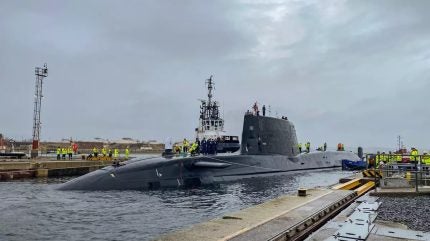
The Labour Party intends to raise the UK’s defence spending to 2.5% of GDP “as soon as resources allow”, Prime Ministerial frontrunner Keir Starmer has said ahead of a visit today (12 April) to the UK’s nuclear submarine site in Cumbria, northern England.
The UK’s current defence expenditure accounts for 2.3% of GDP – approximately $62.8bn in 2023.
Starmer’s promise reflects a tougher line by the Labour Party ahead of the UK elections later this year, in which Starmer is predicted to convincingly oust current Conservative Prime Minister Rishi Sunak, according to recent polls.
Labour has “historically been attacked as weak on national defence”, Wilson Jones, defence analyst at GlobalData, tells Army Technology.
Starmer’s announcement represents an attempt to shore up any potential weak points in Labour’s campaign while appealing to right-leaning voters and defence lobbyists, who have historically favoured the Conservative Party.
It is also proportionate with hikes in defence spending by other European nations amid concerns over escalating conflict with Russia.
How well do you really know your competitors?
Access the most comprehensive Company Profiles on the market, powered by GlobalData. Save hours of research. Gain competitive edge.

Thank you!
Your download email will arrive shortly
Not ready to buy yet? Download a free sample
We are confident about the unique quality of our Company Profiles. However, we want you to make the most beneficial decision for your business, so we offer a free sample that you can download by submitting the below form
By GlobalDataStarmer sets new course for Labour on nuclear weaponry
Starmer also said Labour will make Trident, the UK’s nuclear deterrent, the “bedrock” of its national security agenda.
This clear divergence from former party leader Jeremy Corbyn, who once called for the Trident programme to be scrapped, shows that “Starmer is trying to eliminate any anti-nuclear elements from Labour”, Jones adds.
His remarks have preceded his visit today (12 April) to the BAE Systems shipyard in Barrow-in-Furness, Cumbria, where the UK’s nuclear submarines are being built.
He is the first Labour leader to visit the site in three decades.
Starmer will be joined by John Healey, Shadow Defence Secretary, and Stephen Smith, Australia’s High Commissioner to the UK, in a show of support for the Aukus security pact between the US, UK and Australia – and, increasingly, Japan.
The Labour leader’s pledge has faced heavy criticism from Kate Hudson, general secretary for the Campaign for Nuclear Disarmament, who describes it as “billions of pounds wasted on nuclear weapons and nuclear power”.
“After 14 years of Tory misrule, Starmer’s offer is just more of the same: a belligerent foreign policy that includes support for the Aukus pact, Nato and continuing arms sales to Israel, used to kill Palestinians,” Hudson says.

Starmer said a turbulent geopolitical landscape which has become “more volatile” is his primary reason for raising the defence budget.
Primary to this is European and Nato security, with the UK among the leading donators of arms to Ukraine as it struggles to prevent Russian forces’ incursion across the Bakhmut, Avdiivka and Robotyne frontlines.
But the UK has also expanded its role in naval security operations outside of Europe.
In response to a sequence of Red Sea ship attacks by Yemen’s Houthi militant group, the UK and US jointly launched Operation Prosperity Guardian in December.
Deploying navy vessels to the area has limited the damage caused by the Houthis’ attacks, despite the group killing three people in the first fatal Red Sea ship attack last month.
Where is the UK defence budget being spent?
Trident has long drawn criticism for its astronomical budget – and far-from-spotless testing record.
The costs of developing, maintaining and replacing various aspects of the Trident programme are estimated to exceed $205bn.
While the Barrow shipyard is home to multiple nuclear submarines, most are based at Faslane Royal Navy base near the Firth of Clyde, roughly 40km north-west of Glasgow.
The nuclear warheads are stored at the nearby Coulport armaments depot on Loch Long.
Trident aside, the Royal Navy’s Carrier Strike Group is among the UK’s costliest defence programmes, which are “expensive to build, and especially to maintain”, according to Jones.
“There have been a lot of mechanical issues [with the carriers] in the last few years,” Jones says. “There were also cases of sailors being poisoned from contaminated water and asbestos on board, which requires fixing, medical treatment, and hurts the Royal Navy’s image.”
“In-service and out-of-service dates for Royal Navy submarines are withheld for the purpose of safeguarding national security,” a UK Ministry of Defence (MoD) spokesperson tells Army Technology.
The UK’s ‘Dreadnought’ programme, which will build four Dreadnought Class ballistic missile submarines, remains on track and will see First of Class HMS Dreadnought enter service in the early 2030s, the MoD has said.
The MoD has also said it is still committed to its 2015 promise of delivering seven Astute Class submarines to the Royal Navy.







